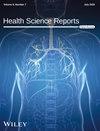The Effects of Hyperkyphosis on Gait Parameters in Older Adults: A Systematic Review
Abstract
Background and Aims
Hyperkyphosis, which affects 20%–40% of older adults, is characterized by excessive thoracic curvature and is linked to impaired mobility. Age-related gait changes further complicate this issue, but studies on the relationship between hyperkyphosis and gait parameters have yielded inconsistent results. Focused research is essential to clarify this relationship and develop effective interventions.
Methods
This systematic review examined the effects of hyperkyphosis on gait in older adults ( ≥ 60 years), adhering to PRISMA 2020 guidelines (PROSPERO registration: CRD42024597304). Observational studies were included, while interventions and studies involving younger populations were excluded. Databases (PubMed, Web of Science, Scopus, CINAHL, Cochrane) were systematically searched. Two independent reviewers screened articles, extracted data, and assessed the risk of bias using validated JBI tools (cohort and cross-sectional checklists). Studies were categorized as high-, moderate-, or low-quality ( ≥ 75%, 50%–74%, and < 50% scores, respectively). Discrepancies were resolved through consensus. Results were synthesized qualitatively, focusing on methodological strengths and limitations.
Results
Nineteen studies focusing on older adults with hyperkyphosis were analyzed, highlighting diverse methods for measuring kyphosis and gait parameters. The findings indicated hyperkyphosis adversely affects gait characteristics, including walking speed, step time, and overall mobility. A strong association was found between increased age, reduced muscle mass, and impaired gait performance.
Conclusion
This review underscores the detrimental impact of hyperkyphosis on gait parameters in older adults, emphasizing the need for standardized measurement protocols and early clinical identification. Targeted interventions are essential to enhance gait performance in this population.


 求助内容:
求助内容: 应助结果提醒方式:
应助结果提醒方式:


